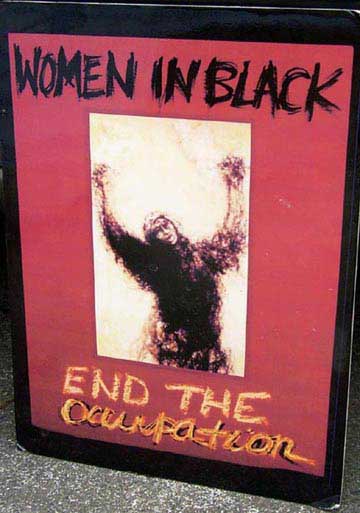I did not know Selma Waldman, but learned of her only after her death in late April 2008. Selma was a Woman
in Black in Seattle. She was a Jew who cared about matters of war and injustice throughout the world. And she
was an artist, her work infused with her politics. I read on the blog of Susan Noyes Platt:
"No artist has more consistently addressed the subject of inhumanity and its relationship to
power than Selma Waldman. Waldman’s entire life and art have been dedicated to the representation of war, capitalism,
in both its victims and its perpetrators."
Susan Platt further writes:
"...no museum will touch her potent work that exposes the intersection of sex, war, and torture. Her most recent series
is on black paper with chalk lines in blue, red, yellow. It is a tangle of passionate and fury that ensnarls interrogators
and victims in a process that has no moral parameters. She declares in the brochure 'War is the Crime, Naked/Aggression is
the work'...The Abu Ghraib series is part of her ongoing project Naked/Aggression that exposes the intersection
of sexuality and war."
Below are several works by Selma Waldman followed by an obituary that appeared in the Seattle Post Intelligencer.
Thank you to Thalia Syracopoulos, a friend and co-vigiler of Selma's, for enriching my life by introducing
me to the work of Selma Waldman.
Selma Waldman, 1931-2008:
Painter had a 'unique touch'
April 22, 2008
By
REGINA HACKETT,
Art
Critic of the Seattle Post Intelligencer
Selma Waldman painted the blunt-force trauma of rape, degradation and murder. In spite
of a growing reputation in Europe and Africa, she was almost unknown in Seattle art circles, even though she lived in the
city since the early 1960s.
James Harris of Seattle's James Harris Gallery happened to see a small exhibit of hers
in a frame shop last year.
“I was blown away by the quality of her drawings, the power of her line and her command
of such an important subject matter,” he said.
| From the Naked/Aggression series |

|
| Charcoal on black paper. From http://artandpoliticsnow.blogspot.com/2007/05/selma-waldman.html |
Her subjects tended to be tough, yet nobody holds such content against Leon Golub, Sue
Coe or Michael Spafford. Harris said Golub's work came to mind when looking at
Waldman's, but it did not overshadow hers.
“Certainly she had her own unique touch,” he said.
Waldman died of cancer last week. She was 77 but until very recently looked much younger.
Politics were as vital to her as art, and she was active all her life in liberation movements around the globe. Her support
for the cause of the Palestinian people was unwavering and absolute, a stance that her son, Rainer Waldman Adkins, thinks
of as embedded in the Jewish tradition of principled dissent.
In Seattle, art dealers, critics and curators tended to avoid her. Fearlessly inventive, she deserved attention and support. Save for a few exceptions (the sculptor Phillip
Levine, the painter David Allison), she got neither.
| Killing Fields: From Behind |

|
| Charcoal, pastel. From www.chgs.umn.edu/museum/exhibitions/absence/artists/sWaldman/index.html |
Waldman was born Feb. 23, 1931, in Kingsville, Texas, where being part of the only Jewish
family in town did not enhance her social life. Her father, Joseph Waldman, was an excellent singer and formidable boxer.
He ran a shoe store. Her mother stayed home raising two daughters and being unhappy much of the time.
Waldman earned a bachelor's degree in art from the University of Texas. Austin was the progressive part of Texas, and my mother for the first
time discovered a community of like-minded people,” said Adkins. One of them she married, an architecture student James
Adkins. Their son was born in 1955, and the couple divorced in the mid-1960s.
In 1959-60, Waldman took her family to Berlin to study art on a Fulbright Fellowship, where
“she was exposed in a visceral, direct way to the Holocaust,” said Atkins.
| From the series, Grief is the Gravity of the Earth |

|
| Charcoal, pastel, acrylic, gesso. From: www.chgs.umn.edu/museum/exhibitions/absence/artists/sWaldman |
The result was the “Falling Man” series of drawings, 25 of which are part of
the permanent collection at the Jewish Museum in Berlin. Other drawings on the Holocaust theme are in the Terezin Ghetto Museum
in the Czech Republic.
Waldman, who worked in a spice shop at Pike Place Market when her son was small, made a
modest living teaching drawing privately and in alternative art settings.
“She'd come home reeking of orange spice tea,” he said. “She fervently
believed anybody could learn to draw.”
She produced eight small books of drawings and writing that document colonial abuse in
Kenya and life in South Africa under apartheid. Her latest series, “Naked Aggression,” deals with the violence
governmental forces inflict upon those they perceive as their enemies, focusing on the U.S. treatment of prisoners in Iraq's
Abu Ghraib prison.
Waldman is survived by her son, an artist and illustrator who is the Seattle chairman of
a Jewish peace group, Brit Tzedek v'Shalom; a daughter-in-law, Deborah Figen; a grandson, Samuel Adkins; and a sister, Maryon,
in Texas.

|
| Women in Black poster designed by Selma Waldman |
|

